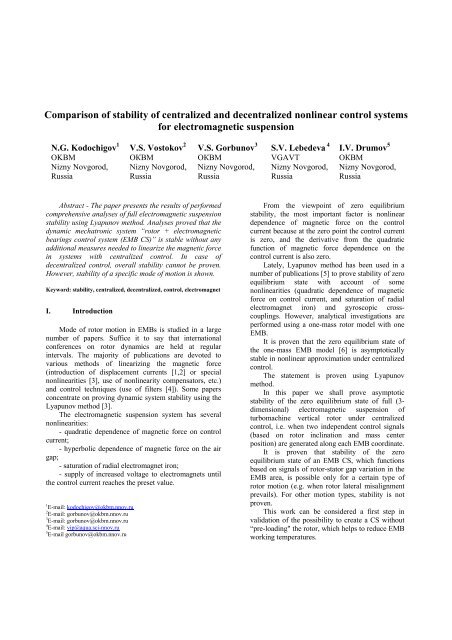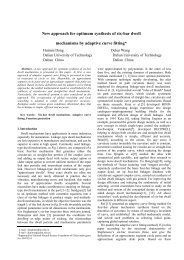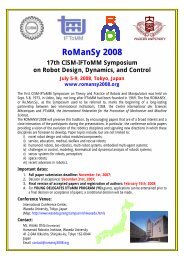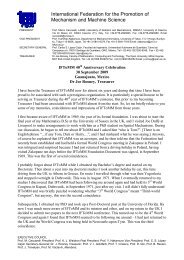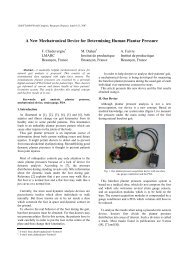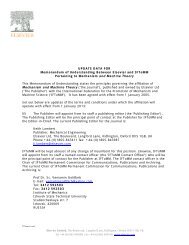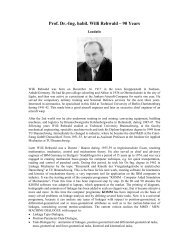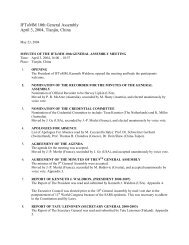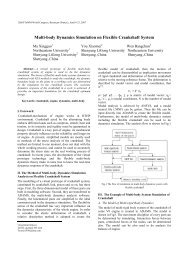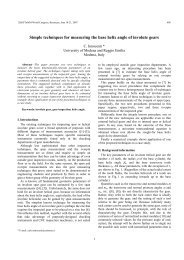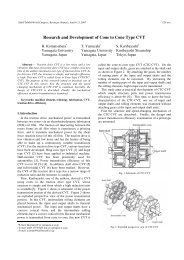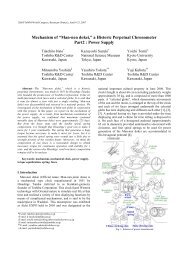Comparison of stability of centralized and decentralized ... - IFToMM
Comparison of stability of centralized and decentralized ... - IFToMM
Comparison of stability of centralized and decentralized ... - IFToMM
Create successful ePaper yourself
Turn your PDF publications into a flip-book with our unique Google optimized e-Paper software.
12th <strong>IFToMM</strong> World Congress, Besanc¸on, June 18-21, 2007<br />
CK-xxx<br />
<strong>Comparison</strong> <strong>of</strong> <strong>stability</strong> <strong>of</strong> <strong>centralized</strong> <strong>and</strong> de<strong>centralized</strong> nonlinear control systems<br />
for electromagnetic suspension<br />
N.G. Kodochigov 1 V.S. Vostokov 2 V.S. Gorbunov 3 S.V. Lebedeva 4 I.V. Drumov 5<br />
OKBM ОКBМ ОКBМ VGАVТ ОКBМ<br />
Nizny Novgorod,<br />
Russia<br />
Nizny Novgorod,<br />
Russia<br />
Nizny Novgorod,<br />
Russia<br />
Nizny Novgorod,<br />
Russia<br />
Nizny Novgorod,<br />
Russia<br />
Abstract - The paper presents the results <strong>of</strong> performed<br />
comprehensive analyses <strong>of</strong> full electromagnetic suspension<br />
<strong>stability</strong> using Lyapunov method. Analyses proved that the<br />
dynamic mechatronic system “rotor + electromagnetic<br />
bearings control system (EMB CS)” is stable without any<br />
additional measures needed to linearize the magnetic force<br />
in systems with <strong>centralized</strong> control. In case <strong>of</strong><br />
de<strong>centralized</strong> control, overall <strong>stability</strong> cannot be proven.<br />
However, <strong>stability</strong> <strong>of</strong> a specific mode <strong>of</strong> motion is shown.<br />
Keyword: <strong>stability</strong>, <strong>centralized</strong>, de<strong>centralized</strong>, control, electromagnet<br />
I. Introduction<br />
Mode <strong>of</strong> rotor motion in EMBs is studied in a large<br />
number <strong>of</strong> papers. Suffice it to say that international<br />
conferences on rotor dynamics are held at regular<br />
intervals. The majority <strong>of</strong> publications are devoted to<br />
various methods <strong>of</strong> linearizing the magnetic force<br />
(introduction <strong>of</strong> displacement currents [1,2] or special<br />
nonlinearities [3], use <strong>of</strong> nonlinearity compensators, etc.)<br />
<strong>and</strong> control techniques (use <strong>of</strong> filters [4]). Some papers<br />
concentrate on proving dynamic system <strong>stability</strong> using the<br />
Lyapunov method [3].<br />
The electromagnetic suspension system has several<br />
nonlinearities:<br />
- quadratic dependence <strong>of</strong> magnetic force on control<br />
current;<br />
- hyperbolic dependence <strong>of</strong> magnetic force on the air<br />
gap;<br />
- saturation <strong>of</strong> radial electromagnet iron;<br />
- supply <strong>of</strong> increased voltage to electromagnets until<br />
the control current reaches the preset value.<br />
1 E-mail: kodochigov@okbm.nnov.ru<br />
2 E-mail: gorbunov@okbm.nnov.ru<br />
3 E-mail: gorbunov@okbm.nnov.ru<br />
4 E-mail: vip@aqua.sci-nnov.ru<br />
5 E-mail gorbunov@okbm.nnov.ru<br />
From the viewpoint <strong>of</strong> zero equilibrium<br />
<strong>stability</strong>, the most important factor is nonlinear<br />
dependence <strong>of</strong> magnetic force on the control<br />
current because at the zero point the control current<br />
is zero, <strong>and</strong> the derivative from the quadratic<br />
function <strong>of</strong> magnetic force dependence on the<br />
control current is also zero.<br />
Lately, Lyapunov method has been used in a<br />
number <strong>of</strong> publications [5] to prove <strong>stability</strong> <strong>of</strong> zero<br />
equilibrium state with account <strong>of</strong> some<br />
nonlinearities (quadratic dependence <strong>of</strong> magnetic<br />
force on control current, <strong>and</strong> saturation <strong>of</strong> radial<br />
electromagnet iron) <strong>and</strong> gyroscopic crosscouplings.<br />
However, analytical investigations are<br />
performed using a one-mass rotor model with one<br />
EMB.<br />
It is proven that the zero equilibrium state <strong>of</strong><br />
the one-mass EMB model [6] is asymptotically<br />
stable in nonlinear approximation under <strong>centralized</strong><br />
control.<br />
The statement is proven using Lyapunov<br />
method.<br />
In this paper we shall prove asymptotic<br />
<strong>stability</strong> <strong>of</strong> the zero equilibrium state <strong>of</strong> full (3-<br />
dimensional) electromagnetic suspension <strong>of</strong><br />
turbomachine vertical rotor under <strong>centralized</strong><br />
control, i.e. when two independent control signals<br />
(based on rotor inclination <strong>and</strong> mass center<br />
position) are generated along each EMB coordinate.<br />
It is proven that <strong>stability</strong> <strong>of</strong> the zero<br />
equilibrium state <strong>of</strong> an EMB CS, which functions<br />
based on signals <strong>of</strong> rotor-stator gap variation in the<br />
EMB area, is possible only for a certain type <strong>of</strong><br />
rotor motion (e.g. when rotor lateral misalignment<br />
prevails). For other motion types, <strong>stability</strong> is not<br />
proven.<br />
This work can be considered a first step in<br />
validation <strong>of</strong> the possibility to create a CS without<br />
“pre-loading" the rotor, which helps to reduce EMB<br />
working temperatures.
II.<br />
Stability <strong>of</strong> zero equilibrium state in a full<br />
electromagnetic suspension with <strong>centralized</strong><br />
control<br />
A. Mathematical model <strong>of</strong> rotor electromagnetic<br />
suspension<br />
The object <strong>of</strong> the study is a vertical rotor in two EMBs.<br />
Displacement current is not used; therefore only<br />
electromagnet windings opposite to rotor displacement<br />
direction are in use. Control <strong>of</strong> rotor axial motion is<br />
organized conventionally <strong>and</strong> is not considered in this<br />
paper. It is assumed that influence <strong>of</strong> vertical forces on the<br />
horizontal constituent is weak.<br />
The complete mathematical model <strong>of</strong> the rotor with<br />
gyroscopic cross couplings is further considered.<br />
The mathematical model <strong>of</strong> rotor uses dynamic<br />
equations in coordinates <strong>of</strong> mass center <strong>and</strong> rotation<br />
angles. The initial model <strong>of</strong> full electromagnetic<br />
suspension with account <strong>of</strong> equations for translational <strong>and</strong><br />
oscillatory motion has the form [2]:<br />
A && α + & βСΩ<br />
= Mα<br />
m && x = F x<br />
(1.1)<br />
A && β − & αСΩ<br />
= M<br />
m && y = F y<br />
,<br />
where α is angle <strong>of</strong> rotor displacement in yz plane<br />
(Figure 1); β is angle <strong>of</strong> rotor displacement in xz plane; x<br />
<strong>and</strong> y are mass center coordinates; А is moment <strong>of</strong> rotor<br />
inertia relatively to each axis lying in the rotor equatorial<br />
plane; m is rotor mass; С is moment <strong>of</strong> rotor inertia<br />
relatively to central rotation axis; Ω is absolute angular<br />
speed <strong>of</strong> rotation around the central axis; F , F are<br />
forces from the radial EMB acting along axes x <strong>and</strong> y;<br />
M M α<br />
,<br />
β<br />
are moments from the radial EMB acting at<br />
angles α <strong>and</strong> β .<br />
B. Control system structure<br />
β<br />
Mathematical model <strong>of</strong> the control system does not<br />
account for sensor response time or current in<br />
electromagnet windings. Centralized control is considered;<br />
that is when mass center based control does not lead to<br />
occurrence <strong>of</strong> the moment <strong>of</strong> force, <strong>and</strong> angle based<br />
control does not lead to displacement <strong>of</strong> the mass center.<br />
Thus it appears that there are no coordinate cross<br />
couplings between equations (1.1). Equations for a<br />
proportional-differential controller are considered. For a<br />
rigid rotor with <strong>centralized</strong> control, position <strong>of</strong> mass center<br />
x<br />
y<br />
<strong>and</strong> rotation angles are calculated based on the<br />
measured rotor displacement in EMBs relative to<br />
the stator central axis. It follows that:<br />
x aα<br />
α вu<br />
= x bα<br />
α l<br />
= −<br />
where u st<strong>and</strong>s for “upper”, l st<strong>and</strong>s for “lower”, а<br />
is the distance between the upper bearing <strong>and</strong> the<br />
rotor mass center; b is the distance between the<br />
lower bearing <strong>and</strong> the rotor mass center; x αu is<br />
calculated rotor displacement (relative to stator<br />
central axis) in the upper bearing, with the fixed<br />
mass center; x αl s calculated rotor displacement<br />
(relative to stator central axis) in the lower bearing,<br />
with the fixed mass center.<br />
Equations for y β <strong>and</strong> β are <strong>of</strong> a similar form.<br />
Equations for forces <strong>and</strong> moments from<br />
electromagnets will be <strong>of</strong> the form:<br />
F<br />
x<br />
= −2k1I<br />
m.<br />
c.<br />
x<br />
I<br />
m.<br />
c.<br />
x<br />
М = −k1(<br />
Iα<br />
u<br />
Iα<br />
u<br />
a − Iα<br />
l<br />
Iα<br />
b)<br />
, (1.2)<br />
α<br />
l<br />
where m.c. st<strong>and</strong>s for “mass center”; k 1 =L 0 /2x 0 ; L 0<br />
is inductivity <strong>of</strong> electromagnet winding with the<br />
rotor in central position; I m.c.x is mass center based<br />
control current; I αl , I αu is angle based control<br />
current; x 0 is nominal air gap in the electromagnet.<br />
Equation (1.2) is written in the assumption that<br />
2 2<br />
( x0 ± ∆x)<br />
≈ x0<br />
(this assumption holds because<br />
out <strong>of</strong> two electromagnets the one that is active is<br />
the one with the air gap larger than x 0<br />
). Here ∆x is<br />
displacement <strong>of</strong> the bearing rotor part relative to the<br />
stator central axis<br />
Equations for F у <strong>and</strong> М β are <strong>of</strong> a similar form.<br />
Let us pass on from equations (1.1) in variables<br />
α,β to new equations in variables x αu , y βu according<br />
to correlations α= x αu /а; β= y βu /а:<br />
& x<br />
y<br />
αв<br />
βв<br />
A + &<br />
СΩ = −k<br />
а a<br />
& y<br />
βв<br />
xα<br />
в<br />
A − & СΩ = −k<br />
I<br />
а a<br />
&&<br />
1<br />
( Iα<br />
в<br />
Iα<br />
в<br />
а − Iα<br />
н<br />
Iα<br />
н<br />
b)<br />
I<br />
а<br />
1<br />
(<br />
βв<br />
βв<br />
−<br />
βн<br />
βн<br />
)<br />
m x = −2k1I m . c.<br />
x<br />
I<br />
m . c.<br />
x<br />
I<br />
I<br />
= k<br />
x + k<br />
x&<br />
I<br />
I<br />
3 3<br />
a + b<br />
= −k1<br />
I<br />
2<br />
a<br />
3 3<br />
a + b<br />
b = −k1<br />
I<br />
2<br />
a<br />
m . c.<br />
x рx dx<br />
(1.3)<br />
α u<br />
I<br />
β u<br />
= k<br />
= k<br />
рα<br />
рβ<br />
x<br />
αu<br />
y<br />
βu<br />
+ k<br />
+ k<br />
dα<br />
dβ<br />
x&<br />
αu<br />
y&<br />
βu<br />
I<br />
αв<br />
αв<br />
I<br />
βв<br />
βв
where k px is proportional coefficient <strong>of</strong> mass center based<br />
controller; k dx is differential coefficient <strong>of</strong> mass center<br />
based controller; k pα, k pβ is proportional coefficient <strong>of</strong> α<br />
<strong>and</strong> β angle based controller; k dα, k dβ is differential<br />
coefficient <strong>of</strong> α <strong>and</strong> β angle based controller.<br />
All coefficients k p <strong>and</strong> k d (with indices) are positive.<br />
Equations for y,I m.c.y are <strong>of</strong> a similar form.<br />
Thus, in assumption <strong>of</strong> <strong>centralized</strong> control, the<br />
equations become independent, which permits us to use<br />
earlier obtained results to write one second-degree<br />
equation [6].<br />
C. System <strong>stability</strong><br />
Control is independent <strong>of</strong> rotor inclination angle <strong>and</strong><br />
mass center deviation from the central axis. It can be easily<br />
shown that system (1.3) can be transformed into two<br />
equations for control current:<br />
2k1<br />
d<br />
2<br />
m I&<br />
m. c.<br />
xI<br />
&<br />
m.<br />
c.<br />
x<br />
+ k<br />
px<br />
( I<br />
m.<br />
c.<br />
x<br />
I<br />
m.<br />
c.<br />
xI<br />
m.<br />
c.<br />
x<br />
) = −4k1kdx<br />
⋅ I<br />
m.<br />
c.<br />
x<br />
( I&<br />
m.<br />
c.<br />
x<br />
)<br />
3 dt<br />
<strong>and</strong><br />
3 3<br />
A<br />
a b<br />
2<br />
[ I&&<br />
u<br />
I&<br />
u<br />
I&&<br />
uI<br />
& +<br />
⋅<br />
α α<br />
+<br />
β βu<br />
] = − k1<br />
⋅{[<br />
k ( ) 2 ( ) ]<br />
2<br />
p<br />
I<br />
u<br />
I<br />
uI<br />
&<br />
α α α αu<br />
+ kd<br />
α<br />
Iα<br />
u<br />
I&<br />
αu<br />
+<br />
a<br />
a<br />
2<br />
+ [ k ( I I I&<br />
) + 2k<br />
I ( I&<br />
) ]}.<br />
pβ<br />
βв<br />
βв<br />
βв<br />
dβ<br />
βв<br />
βв<br />
So, the sought variables are control currents I m.c.x,<br />
I m.c.y, I αu, I βu.<br />
The Lyapunov function has the form (1.4):<br />
2<br />
2<br />
I&<br />
I&<br />
m.<br />
c.<br />
x m.<br />
c.<br />
y 2k1<br />
2<br />
2<br />
v = m + m + ⋅{<br />
kpx<br />
Im . c.<br />
x<br />
Im . c.<br />
x<br />
+ kpy<br />
Im . c.<br />
y<br />
Im . c.<br />
y}<br />
+<br />
2 2 3<br />
(1.4)<br />
2 2 3 3<br />
I&<br />
I&<br />
αu<br />
βu<br />
k1<br />
a + b<br />
2<br />
2<br />
A + A + ⋅{<br />
k + } > 0<br />
2 pα<br />
Iαu<br />
Iαu<br />
kpβ<br />
Iβu<br />
Iβu<br />
2а<br />
2а<br />
3 a<br />
<strong>and</strong> accordingly, its derivative taken with account <strong>of</strong><br />
original equations is:<br />
3 3<br />
2<br />
2 a + b<br />
2<br />
2<br />
− 4k1 ⋅{<br />
kdx<br />
Im.<br />
c.<br />
x<br />
I&<br />
m.<br />
c.<br />
x<br />
+ kdy<br />
Im.<br />
c.<br />
y<br />
I&<br />
m.<br />
c.<br />
y<br />
} − 2k1<br />
⋅{<br />
k + } < 0<br />
2 d<br />
I<br />
u<br />
I&<br />
α α αu<br />
kdβ<br />
I<br />
βu<br />
I&<br />
βu<br />
a<br />
At the same time,<br />
d<br />
dt<br />
( I I)<br />
= 2 I I&<br />
.<br />
d<br />
dt<br />
( I II)<br />
= 3 I II&<br />
, <strong>and</strong><br />
Based on the above, we can conclude that equilibrium<br />
state<br />
= = = = = =<br />
x<br />
y<br />
I<br />
I<br />
I<br />
=<br />
m. c.<br />
x m.<br />
c.<br />
у u βu<br />
αl<br />
βl<br />
=<br />
α<br />
is<br />
asymptotically stable. Thus, asymptotic <strong>stability</strong> <strong>of</strong> the<br />
nonlinear system <strong>of</strong> full electromagnetic suspension is<br />
proven.<br />
It should be noted that <strong>stability</strong> is proven in variables<br />
or:<br />
I<br />
I<br />
I<br />
0<br />
Im. c.<br />
x;<br />
Iα u;<br />
I βu<br />
; but it follows from<br />
I = k x + k x&<br />
that<br />
α u<br />
рα<br />
αu<br />
αu<br />
+ kdα<br />
xαu<br />
dα<br />
αu<br />
k<br />
р<br />
x &<br />
α → 0 . So it is evident that<br />
x α u<br />
→ 0 if t → ∞ . Thus, we can assert that<br />
<strong>stability</strong> in variables α , & α is also proven. The same<br />
holds for x , x& , y,<br />
y&<br />
,β.<br />
III.<br />
System <strong>stability</strong> with account <strong>of</strong> inertia<br />
<strong>of</strong> control current build-up in<br />
electromagnet winding<br />
In order to simplify things, we will consider the<br />
case <strong>of</strong> rotor holdup in one coordinate (e.g. along x<br />
axis).<br />
The equation for control current with account<br />
<strong>of</strong> current inertia in EMB winding is written as<br />
follows:<br />
k<br />
p<br />
x + kd<br />
x& = τ I&<br />
+ I, (2.1)<br />
where k p is controller proportional coefficient;<br />
k d is controller differential coefficient;<br />
τ is time constant <strong>of</strong> electromagnet winding<br />
L 0<br />
τ = ; R is EMB winding resistance.<br />
R<br />
If we introduce dimensionless quantity<br />
~ t<br />
t = ,<br />
τ<br />
equation (2.1) will be transformed into:<br />
dI kd dx<br />
I k<br />
px<br />
dt<br />
~ + = +<br />
τ dt<br />
~ . (2.2)<br />
Equations (1.1) are transformed in the same<br />
way:<br />
2<br />
m d x L0<br />
I I<br />
2 2<br />
dt<br />
~ = − .<br />
τ 2x0<br />
2<br />
2<br />
d x L0τ<br />
Substituting<br />
I I<br />
dt<br />
~ = −<br />
into (2.2),<br />
2x0m<br />
we receive:<br />
2<br />
d I dI kdτL0<br />
dx<br />
I I k<br />
p<br />
dt<br />
~ +<br />
dt<br />
~ = − +<br />
2<br />
2x<br />
m dt<br />
~ . (2.3)<br />
0<br />
If we define expressions to the left <strong>of</strong> I I <strong>and</strong><br />
( I I)<br />
dt<br />
~<br />
∫<br />
as c <strong>and</strong> h, we obtain:<br />
2<br />
d I dI<br />
( )<br />
~<br />
~ + ~ + c I I + h = 0<br />
2 ∫ I I dt<br />
,<br />
dt dt
2<br />
d I dI d<br />
h I I dt<br />
~<br />
h I I dt<br />
~<br />
~ + ~ + ~ ( ) ) ( ) ( c h)<br />
I I<br />
dt dt dt<br />
( + = − − .(2.4)<br />
2 ∫ ∫<br />
Multiplying the left <strong>and</strong> right sides <strong>of</strong> equation (2.4) by<br />
dI h I I)<br />
dt<br />
~<br />
dt<br />
~ + ∫ ( , we obtain:<br />
dI ~ 2<br />
( ~ + h∫<br />
( I I)<br />
dt )<br />
d<br />
( ) ~<br />
~ [ dt<br />
c − h c − h<br />
2<br />
+ I II + ( h ( ) ) ]<br />
2<br />
3 2<br />
∫ I I dt =<br />
dt<br />
h<br />
dI<br />
( ( )<br />
~ 2<br />
= − ~ + h∫<br />
I I dt ) ,<br />
dt<br />
or:<br />
dI<br />
2<br />
(<br />
~<br />
~ + h∫(<br />
I I)<br />
dt )<br />
c −h<br />
( c −h)<br />
~ 2<br />
v =<br />
dt<br />
+ I II + ( h ( ) )<br />
2 3 2<br />
∫ I I dt<br />
, (2.5)<br />
b<br />
d dI<br />
( )<br />
~<br />
~ ν = −(<br />
~ + h∫ I I dt<br />
)<br />
2 < 0 .<br />
dt dt<br />
2<br />
kdτL<br />
k<br />
0<br />
pτ<br />
L0<br />
If c = <strong>and</strong> h = , <strong>stability</strong> condition<br />
2x0m<br />
2x0m<br />
c>h transforms into inequality k d<br />
> k p<br />
τ .<br />
The obtained result can be used in studies <strong>of</strong> <strong>stability</strong><br />
<strong>of</strong> full rotor suspension described above. Thus, as there are<br />
no cross-couplings between the equations, <strong>stability</strong> <strong>of</strong> full<br />
electromagnetic suspension with <strong>centralized</strong> CS <strong>and</strong> with<br />
account <strong>of</strong> current inertia in EMB winding can be<br />
considered proven<br />
.<br />
IV. Stability <strong>of</strong> full electromagnetic suspension <strong>of</strong><br />
vertical rotor with a de<strong>centralized</strong> CS<br />
Let us consider one coordinate, neglecting gyroscopic<br />
forces, since it was shown above that they do not affect the<br />
result but only make calculations bulkier.<br />
Original equations have the form<br />
mX<br />
1"<br />
= −F(<br />
X<br />
1)<br />
+ F(<br />
X<br />
2<br />
)<br />
,<br />
mX<br />
2"<br />
= −F(<br />
X<br />
2<br />
) + F(<br />
X<br />
1)<br />
where Х 1 <strong>and</strong> Х 2 are coordinates <strong>of</strong> the upper <strong>and</strong> lower<br />
bearings.<br />
After transformations similar to those described in<br />
Section 1, we receive cross terms I I 1 2<br />
' <strong>and</strong> I I ' 2 1<br />
that do<br />
not permit to conclude whether the Lyapunov function or<br />
its derivative are sign-constant.<br />
Next, we replace control currents I1 <strong>and</strong> I2 <strong>and</strong> their<br />
derivatives with angle <strong>and</strong> mass center based control<br />
currents (analogous to replacement <strong>of</strong> variables). After<br />
addition <strong>of</strong> the cross terms we receive only eigenproducts<br />
I I α α<br />
' <strong>and</strong> I ' c. m.<br />
I<br />
c.<br />
m.<br />
, but <strong>of</strong> different signs.<br />
If we introduce them under the derivative sign,<br />
we receive additional terms in the Lyapunov’s<br />
2 2<br />
−<br />
function that have the form <strong>of</strong><br />
I + I α m . c . <strong>and</strong><br />
are identically equal to zero. Thus, on the one h<strong>and</strong>,<br />
<strong>stability</strong> cannot be concluded as the resulting<br />
function is not sign-constant; but we can assume<br />
that if one component is always greater than the<br />
other (e.g. if parallel rotor motion prevails), then<br />
<strong>stability</strong> will be ensured. Numerical calculations on<br />
more detailed nonlinear models <strong>and</strong> experiments<br />
with vertical rotors confirm that such assumption<br />
can be true.<br />
V. Conclusions<br />
A. Analyses <strong>of</strong> full electromagnetic suspension<br />
<strong>stability</strong> performed using Lyapunov method<br />
proved that the dynamic mechatronic system<br />
“rotor + CS” is stable without any additional<br />
measures to linearize the magnetic force.<br />
B. Preference should be given to <strong>centralized</strong><br />
control systems.<br />
C. The demonstrated result <strong>of</strong> performed analyses<br />
is <strong>of</strong> practical value as it permits to ab<strong>and</strong>on use<br />
<strong>of</strong> displacement currents that linearize the<br />
system but lead to overheat <strong>of</strong> electromagnet<br />
windings.<br />
References.<br />
[1] Yu.N. Zhuravlev. Active magnetic bearings. Theory,<br />
calculation <strong>and</strong> application // Saint Petersburg.<br />
Polytechnnics, 2003.<br />
[2] Schweitzer G., Bleuler H., Traxler A. Active<br />
Magnetic Bearings. Zurich: Vdf Hochschulverlag AG<br />
an der ETH, 1994.<br />
[3] Ariga Y., Nonami K., Sakai K. Nonlinear control <strong>of</strong><br />
zero power magnetic bearing using Lyapunov’s direct<br />
method // Proc. 7-th Int. Symp. on EВ, Zurich: ETH,<br />
2000. P. 23-25.<br />
[4] Fujiwara H., Matsushita O., Okubo H. Stability<br />
evaluation <strong>of</strong> high frequency eigen modes for active<br />
magnetic bearing rotors // Proc.7-th Int. Symp. on<br />
EВ,Zurich:ETH,2000.P.85-88.<br />
[5] Yu.G. Martynenko. Motion <strong>of</strong> hard bodies in<br />
electromagnetic fields // M.: Nauka, 1988.<br />
[6] F.M. Mitenkov, N.G. Kodochigov, V.S. Vostokov<br />
etc. Complex <strong>of</strong> analytical, methodic experimental<br />
investigations <strong>of</strong> rotor motion in electromagnetic<br />
suspension // Nuclear Energy, 2005. Vol.99, Iss. 1,<br />
pp. 26-33.


